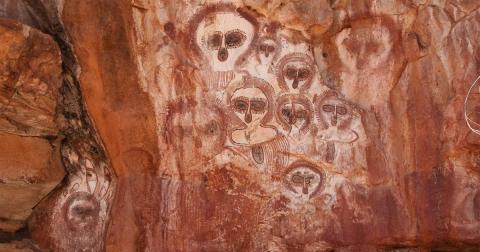One of the most intriguing and perplexing legends of the Australian Aboriginal people is that of the Wandjinas, the supreme spirit beings and creators of the land and people. The land of the Wandjina is a vast area of about 77,220 square miles in the Kimberley region of north-western Australia. This region has continuously been important for indigenous culture since at least 60,000 years ago, and probably much longer.
The Worora, Ngarinyin, and Wunumbul people are three Wandjina tribes and the custodians of the oldest known figurative art which is scattered throughout the Kimberley area. Perhaps what is most interesting about their art painted on rocks and in caves is the way in which they have represented the Wandjinas - white faces, devoid of a mouth, large black eyes, and a head surrounded by a halo or some type of helmet.
The ancient paintings have received all manner of interpretations from stylized representations of people or even owls, to ancient astronaut theories - which suggest that extraterrestrial beings visited Earth tens of thousands of years ago and had direct contact with the inhabitants. Some believe that the extraterrestrials even played a direct role in creation, which is reflected not only in the Dreamtime stories of the Aboriginals but also the myths and legends of many ancient civilizations around the world.
One could be forgiven for thinking that there is indeed a remarkable similarity between the Wandjinas and the stereotypical image of an extraterrestrial which we see time and again in art, movies, and witness accounts. And many people raise logical questions such as, why were the Wandjinas painted with white skin if it was representing another Aboriginal, all of whom had black skin? Why were the eyes always painted so disproportionate to the face and nose? And why were they all painted without a mouth?
Two explanations have been given for the absence of mouths. The first is that they are so powerful that they do not need speech. The second is that traditionally it was believed that if they had mouths, the rain would never cease.
The oral account of the Wandjinas, passed from generation to generation, says they were “sky-beings” or “spirits from the clouds” who came down from the Milky Way during Dreamtime and created the Earth and all its inhabitants. Then Wandjina looked upon the inhabitants and realized the enormity of the task and returned home to bring more Wandjinas. With the aid of the Dreamtime Snake, the Wandjina descended and spent their Dreamtime creating, teaching, and being Gods to the Aboriginals whom they created. After some time, the Wandjinas disappeared. They descended into the Earth and have lived at the bottom of the water source associated with each of the paintings since then. There, they continually produce new ‘child-seeds’, which are regarded as the source of all human life. Some Wandjina also returned to the sky and can now be seen at night as lights moving high above the earth.
Today, the Aboriginal tribes of the Worora, Ngarinyin, and Wunumbul still revere the Wandjina and only certain individuals are given permission to paint them. It is said that the Wandjina could punish those who broke the law with floods, lightening, and cyclones - and the paintings of the Wandjina are believed to possess these powers, therefore according to the Aboriginals they are always to be approached and treated respectfully.
By Joanna Gillan




